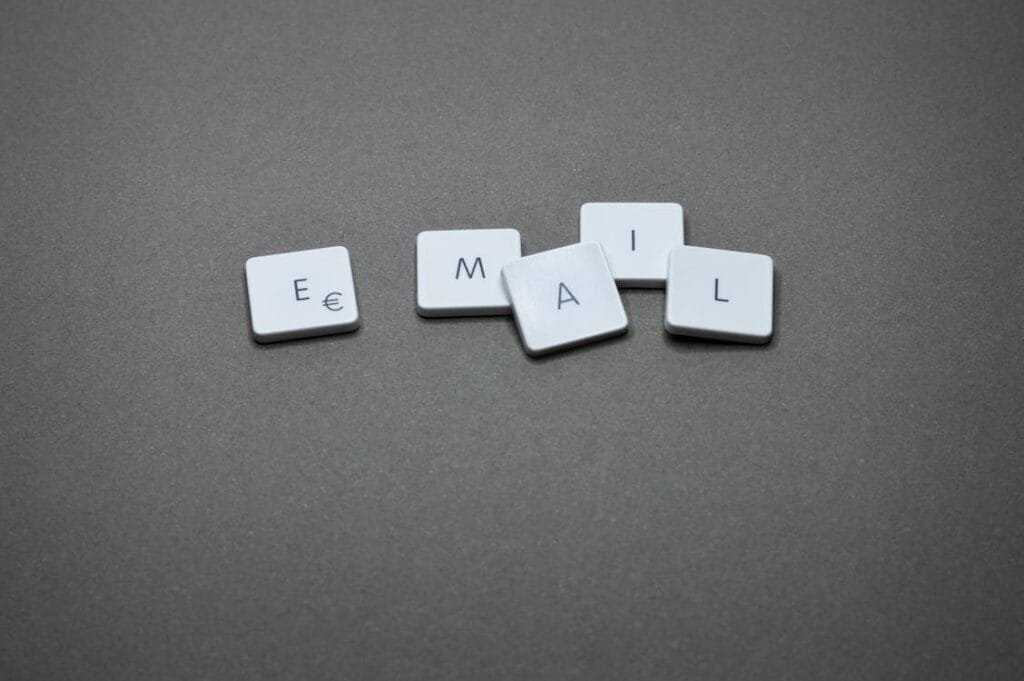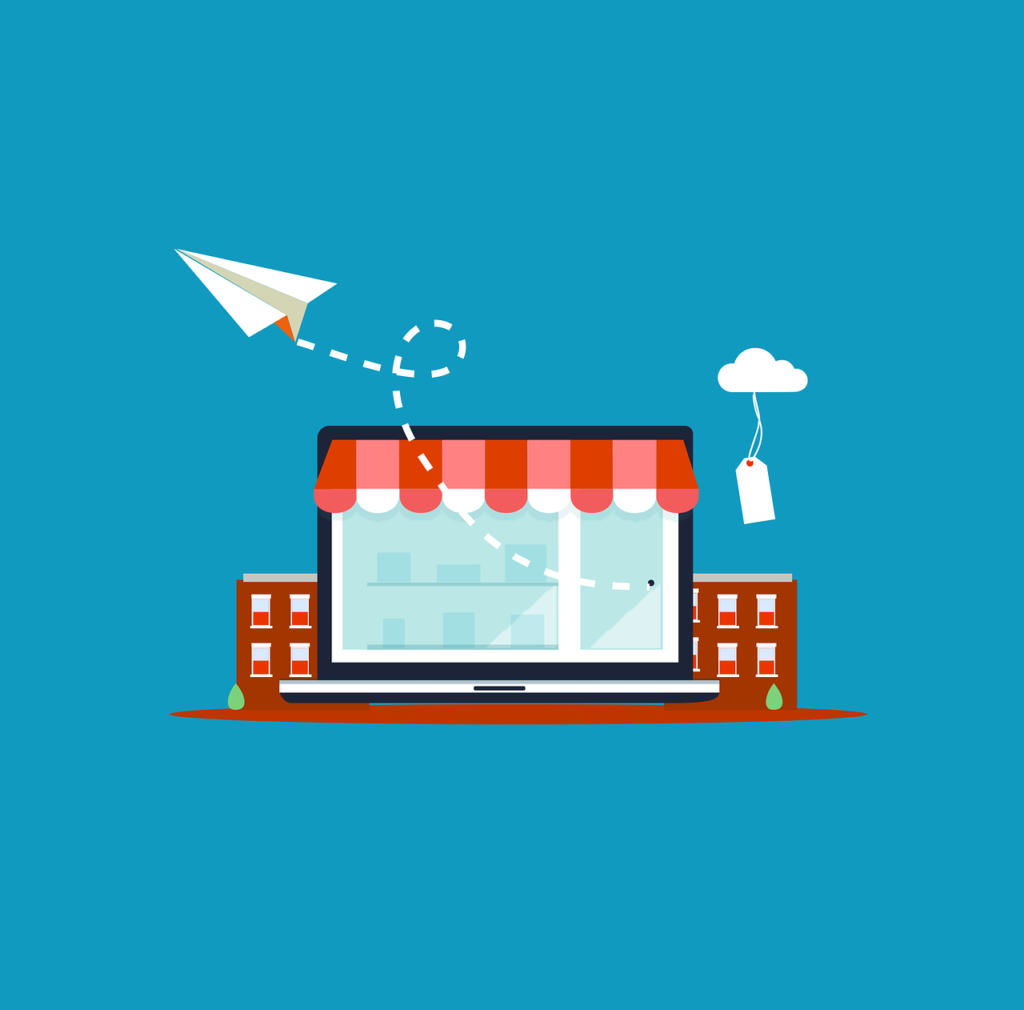In today’s rapidly evolving digital landscape, businesses are constantly chasing the next big customer base, often overlooking a goldmine they already possess – their existing customers.
Studies repeatedly suggest that acquiring a new customer costs several times more than retaining an existing one. Yet, marketing strategies often disproportionately lean towards acquisition rather than retention. It’s high time organizations rethink this approach, turning their focus towards a more sustainable, loyalty-driven advertising paradigm – Retention Advertising.
The concept is not about merely keeping customers but transforming them into brand ambassadors who organically spread the word about your products or services. Imagine the impact of a single satisfied customer sharing their positive experience with their vast social network versus the cost of a broad-scale advertising campaign to achieve the same reach. That’s the power of Retention Advertising.
As we delve deeper into this comprehensive guide, we’ll unearth the secrets of fostering unwavering customer loyalty and ensuring sustained business growth.
Understanding the Importance of Customer Loyalty
Loyal customers are akin to assets with appreciating value. Over time, their consistent purchasing behavior often results in a significantly higher value than that of a series of one-time buyers. The logic is simple: repeat customers lead to consistent revenue streams. Their familiarity with the brand often translates to larger purchase volumes and higher average order values.
The Role of Loyalty in Referrals and Organic Promotions
There’s a ripple effect to customer loyalty that’s hard to replicate with any advertising budget. Loyal customers naturally become brand advocates, referring friends, family, and colleagues. This word-of-mouth marketing, backed by genuine user experience, often resonates more deeply than even the most sophisticated ad campaigns.
Impact of Customer Loyalty on Brand Reputation
In a digital age where online reviews and feedback can make or break a brand, loyal customers play a pivotal role. Their positive testimonials, reviews, and social media endorsements boost a brand‘s online reputation. On the flip side, addressing concerns and turning around a negative experience can transform a disgruntled customer into a loyal advocate, showcasing a brand’s commitment to customer satisfaction.
The Shift from Acquisition to Retention Advertising
Traditional advertising models have been largely driven by the thrill of the chase – acquiring new customers. Billboards, TV commercials, and even early digital ads were designed to capture attention, create brand awareness, and reel in potential customers. The metrics of success were centered around reach, impressions, and new customer onboarding.
The Evolving Paradigm: Why Retention Advertising is Taking the Center Stage
However, as the digital marketplace gets increasingly saturated and customer acquisition costs skyrocket, the focus is steadily shifting towards retention. Brands are realizing the untapped potential of existing customers. Not only are they easier to sell to (thanks to established trust), but they’re also more likely to buy premium products or upsell options. Moreover, the digital age, with its myriad communication channels, offers brands numerous touchpoints to re-engage and nurture their existing customer base.
Retention advertising, thus, is no longer a choice but a necessity. It champions the idea of celebrating existing customers, understanding their needs, and continuously adding value to keep them engaged and loyal.

Identifying and Segmenting Your Current Customer Base
Building a robust retention advertising strategy starts with an in-depth understanding of your current customer base. Without a clear picture of who they are, what they want, and how they interact with your brand, any retention efforts can miss the mark.
The Significance of Understanding Your Customer Demographics and Behaviors
Customer profiling isn’t just a fancy buzzword; it’s the cornerstone of effective retention advertising. Demographic data such as age, gender, location, and income level can provide a surface-level understanding. However, diving deeper into psychographics – interests, habits, values, and purchasing motivations – can offer profound insights.
By analyzing purchase histories, feedback forms, and engagement metrics, brands can uncover patterns. For instance, if a majority of repeat customers belong to a particular age group or show keen interest in a specific product category, these insights can shape targeted advertising campaigns.
Tactics for Segmenting Based on Purchase Behavior, Engagement Levels, and Feedback
Segmentation is the process of categorizing your broad customer base into smaller, more defined groups. This granularity allows for more personalized and relevant advertising campaigns. Here are some tactics:
Purchase Behavior: Classify customers based on their buying frequency, average order value, and the categories they shop from. This helps in sending targeted promotions or introducing them to new products that align with their interests.
Engagement Levels: Monitor how often customers engage with your brand, be it through opening emails, clicking on ads, or interacting on social media. Higher engagement levels might indicate a customer’s openness to loyalty programs or premium services.
Feedback and Reviews: Actively seek and segment based on customer feedback. Satisfied customers can be targeted for referral programs, while those with concerns or complaints can be re-engaged through personalized offers or solutions addressing their pain points.
Personalization: The Key to Retention Advertising
In an era of information overload, personalization is not just preferred but expected by customers. A generic, one-size-fits-all advertisement can get lost in the noise, while a personalized message can create a deeper connection.
Why Personalized Advertising Resonates Better with Existing Customers
Existing customers have a history with your brand. They’ve interacted with your products or services, made purchases, and possibly even provided feedback. This history is a goldmine of data that can be used to tailor advertising messages. Personalized ads can evoke a feeling of being valued and understood, which can significantly boost retention rates.
Strategies to Personalize Ad Content Based on Customer Data and Previous Interactions
Behavioral Triggers: Use tools that allow for automated ad campaigns based on specific customer actions. For instance, if a customer added a product to their cart but didn’t purchase, a personalized ad or discount could nudge them to complete the sale.
Data Analytics: Analyze data to understand individual customer preferences and tailor advertisements accordingly. If a segment of your customer base consistently purchases eco-friendly products, targeted ads showcasing your brand’s sustainability efforts can resonate deeply.
Feedback Incorporation: If a customer had a specific issue or suggestion in the past, showcasing improvements or new offerings addressing that feedback can create a sense of being heard and valued.
Effective Channels for Retention Advertising
In the vast digital ecosystem, multiple channels offer brands the opportunity to connect with their customers. However, not all channels are created equal when it comes to retention advertising. Let’s dive deep into some of the most effective ones.
Email Campaigns: Tips for Crafting Loyalty-Boosting Content
Email remains one of the most direct and personal ways to communicate with customers. For many businesses, it’s the primary tool for retention.
Segmentation is Key: Different customer groups require different messages. Segmenting your email list ensures you send the right message to the right people, thereby increasing engagement and reducing unsubscribe rates.
Exclusive Offers: Reward your subscribers with email-exclusive deals or early access to sales. This not only incentivizes them to stay subscribed but also to make repeat purchases.
Content Beyond Promotions: While offers are enticing, continually sending promotional content can be overwhelming. Mix in value-driven content like how-to guides, company updates, or spotlighting customer stories.
Social Media: Utilizing Organic Posts and Targeted Ads
Social media platforms are where your customers spend a significant amount of their time, making them prime real estate for retention advertising.
Engage Regularly: Consistent posting keeps your brand top-of-mind. Share behind-the-scenes content, celebrate milestones, and occasionally spotlight loyal customers.
Use Retargeting Ads: Platforms like Facebook allow for targeted ads based on user behavior on your website. If a customer looked at a product but didn’t purchase, a timely ad might nudge them back.
Leverage User-Generated Content (UGC): Sharing reviews, photos, or stories from real customers adds a layer of authenticity to your brand messaging.
Mobile App Notifications: Best Practices to Engage Without Annoying
For businesses with mobile apps, push notifications can be a powerful retention tool but should be used judiciously.
Optimize Frequency: Too many notifications can lead to app deletions. Use them for significant events or offers, ensuring they bring real value.
Personalize the Message: Just like emails, the more tailored a push notification is, the more effective. If a customer often shops in a specific category, notify them of related sales or new arrivals.
Provide Clear CTAs: Whether it’s “Shop Now,” “Learn More,” or “Leave Feedback,” make sure the action you want the user to take is clear.

Crafting Retention-Oriented Ad Content
Content is the core of any advertising effort. However, retention advertising requires a nuanced approach that strikes a balance between reminding customers of your value proposition and offering them new reasons to stay loyal.
The Psychology of Retention Advertising
Understanding the underlying principles of customer psychology can significantly enhance ad effectiveness. People want to feel valued, recognized, and rewarded for their loyalty. They seek validation for their choices, and retention advertising should offer that assurance.
Tips for Creating Content that Reminds, Rewards, and Re-engages
Highlight the Community: Showcase the larger community of loyal customers. When people see others like them enjoying a product or service, they’re more likely to stick around.
Special Offers for Loyalists: Create campaigns specifically targeting long-term customers. Exclusive deals or early-bird offers can make them feel valued.
Educate and Update: Always keep your customers in the loop about new product launches, updates, or any changes. This ensures they always feel connected and informed.
Examples of Brands that Have Nailed Retention Ad Content
Take Starbucks for instance. Their reward program advertisements not only highlight the benefits of earning points but also the sense of belonging to a community of coffee lovers. Such ads provide existing members with a sense of validation and encourage more consistent engagement with the brand.
Reward Programs and Their Role in Retention Advertising
Loyalty isn’t just an emotion; it can be cultivated and harnessed through tangible means. Reward programs are quintessential tools for this, and when blended with advertising, they can amplify customer retention multifold.
The Benefits of Integrating Rewards in Your Ads
Encourages Repeat Business: When customers know that their purchases contribute to earning rewards, they are more likely to keep coming back.
Differentiates Your Brand: In a crowded marketplace, a robust rewards program advertised effectively can set your brand apart.
Facilitates Data Collection: Membership sign-ups for reward programs can provide invaluable customer data, offering insights into purchasing habits, preferences, and behaviors.
Strategies for Promoting Loyalty Programs through Advertising
Highlight Immediate Benefits: People love instant gratification. Emphasize any immediate rewards or benefits they would get upon signing up, like a discount or bonus points.
Use Engaging Visuals: Depict rewards vividly – whether it’s a free product, a special discount badge, or an exclusive event invitation.
Promote Exclusive Experiences: More than just tangible rewards, emphasize any unique experiences that come with your loyalty program, like exclusive events or early access to sales.
Success Story: How a Reward-centric Ad Campaign Increased Customer Repeat Rate
Consider the success of Sephora’s Beauty Insider program. Their advertising doesn’t just focus on points; it underscores experiences – exclusive events, birthday gifts, and early access to products. Through effective advertising of these rewards, Sephora has seen a notable increase in repeat purchases and a surge in loyalty program sign-ups. They have managed to create a community of beauty enthusiasts who eagerly engage with the brand.
Retargeting: Engaging the Almost-Lost Customers
Every marketer knows the pain of the almost-conversion: the filled cart that was never checked out, the product page visited multiple times without a purchase. Enter retargeting, a strategy that brings back those customers on the edge of conversion.
The Science Behind Retargeting and Its Effectiveness
Retargeting works on a simple principle: tracking potential customers through cookies and then showing them relevant ads as they browse other parts of the web. It’s effective because:
Relevance: Ads are tailored based on products or pages the user showed interest in.
Top-of-Mind Recall: Regular, gentle reminders keep your brand in the customer’s mind, increasing the chances of them returning.
Higher Conversion Rates: Retargeted users, already familiar with the product, are more likely to convert.
Setting Up Retargeting Campaigns: Tools and Best Practices
Choose the Right Platform: Tools like Google Remarketing and Facebook Pixel allow for sophisticated retargeting campaigns.
Segmentation: Don’t retarget everyone in the same way. Segment your audience based on their behaviors and interests to make ads more relevant.
Frequency Capping: Too much of anything is harmful. Ensure you’re not bombarding users with ads, leading to ad fatigue.

Utilizing Customer Feedback in Retention Ads
Feedback isn’t just about addressing concerns; it’s a goldmine of insights for creating resonating ad campaigns. As today’s savvy consumers trust peer reviews more than brand messages, integrating real feedback into your ads can drastically improve retention.
The Trust-building Impact of Showcasing Real Customer Feedback
At its core, trust is what drives retention. Demonstrating that other customers have had positive experiences with your brand can reduce skepticism in potential customers. This “social proof” acts as an endorsement, assuring customers of their decision to choose you. Moreover:
Increased Credibility: Authentic feedback amplifies your brand’s transparency and honesty.
Creates a Connection: Real reviews resonate more than polished brand messages, bridging the gap between companies and consumers.
Boosts Conversion Rates: Seeing positive reviews can be the nudge a potential customer needs to make a purchase.
Strategies for Incorporating Feedback, Testimonials, and Reviews in Ads
Use Genuine Testimonials: Avoid generic or fabricated testimonials. Real words from real customers hold more weight.
Incorporate User-Generated Content (UGC): Photos, videos, or quotes from customers can be pivotal. If someone proudly posts about their new purchase, consider leveraging that content (with permission) in your ads.
Address Negative Feedback: It sounds counterintuitive, but addressing negative feedback head-on, and highlighting how you’ve improved, can increase trust manifold.
Example: A Business That Elevated Its Loyalty Metrics Using Feedback-driven Ads
Airbnb, the global travel community, has excelled in using user feedback for advertising. Their campaigns often showcase genuine reviews from hosts and travelers. By emphasizing shared experiences and authentic interactions, they not only highlight the uniqueness of each listing but also build trust with potential users. Such tactics have fortified Airbnb’s image as a platform that values its community, leading to increased loyalty and repeat bookings.
Analyzing the Performance of Retention Advertising Campaigns
Like any strategic initiative, the effectiveness of retention advertising must be measured and optimized over time. With the right metrics and tools, you can fine-tune your campaigns for better outcomes.
Key Metrics: Customer Lifetime Value (CLTV), Repeat Purchase Rate, Net Promoter Score
Customer Lifetime Value (CLTV): This metric evaluates the total revenue a business can reasonably expect from a single customer account. It reflects a customer’s value over time, helping businesses determine their advertising ROI.
Repeat Purchase Rate: By understanding how often customers come back to make subsequent purchases, companies can gauge the success of their retention strategies.
Net Promoter Score (NPS): An index ranging from -100 to 100, it gauges the willingness of customers to recommend a company’s products or services to others. A higher NPS indicates greater customer satisfaction and loyalty.
Tools and Platforms for Retention Ad Analytics
#1. Google Analytics
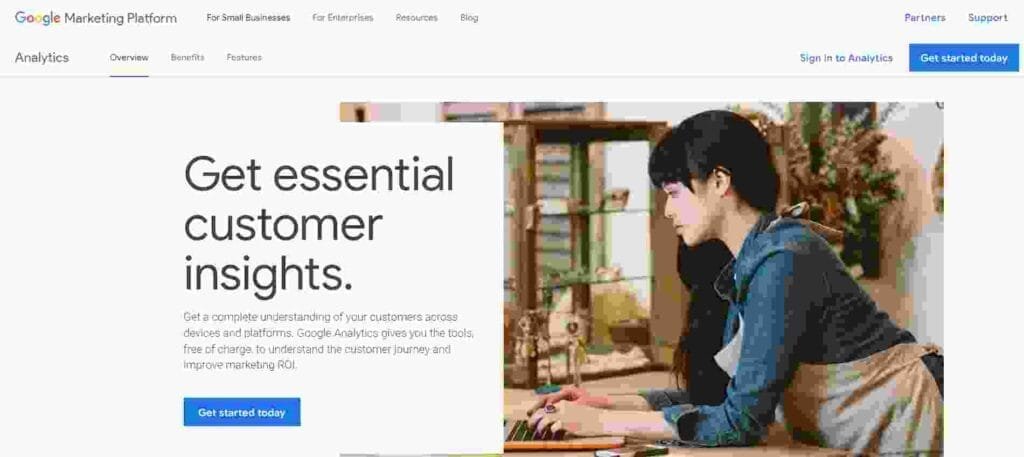
Features
- Comprehensive website and mobile app tracking.
- Audience demographics, interests, and behavior insights.
- Advanced segmentation, funnel visualization, and event tracking.
Pricing
- Free for basic version.
- Google Analytics 360 (premium version) pricing varies based on specific business needs.
Pros
- Widely adopted and integrated.
- Robust free version available.
Cons
- Steeper learning curve for beginners.
- Data sampling in the free version for large datasets.
#2. Mixpanel

Features
- User journey tracking.
- Retention analysis and funnel reports.
- Custom event-based analytics.
Pricing
- Free for limited data points.
- Paid plans start at $25/month based on data points.
Pros
- Intuitive interface.
- Powerful event-based tracking.
Cons
- Cost can escalate with increased data points.
- Limited integrations compared to other platforms.
#3. Adobe Analytics

Features
- Real-time analytics and detailed segment analysis.
- Predictive analytics with AI-assist.
- Multi-channel data integration.
Pricing
- Custom pricing based on specific business needs.
Pros
- In-depth analytics capabilities.
- Strong multi-platform integrations.
Cons
- Expensive for small businesses.
- Complex setup process.
#4. Kissmetrics
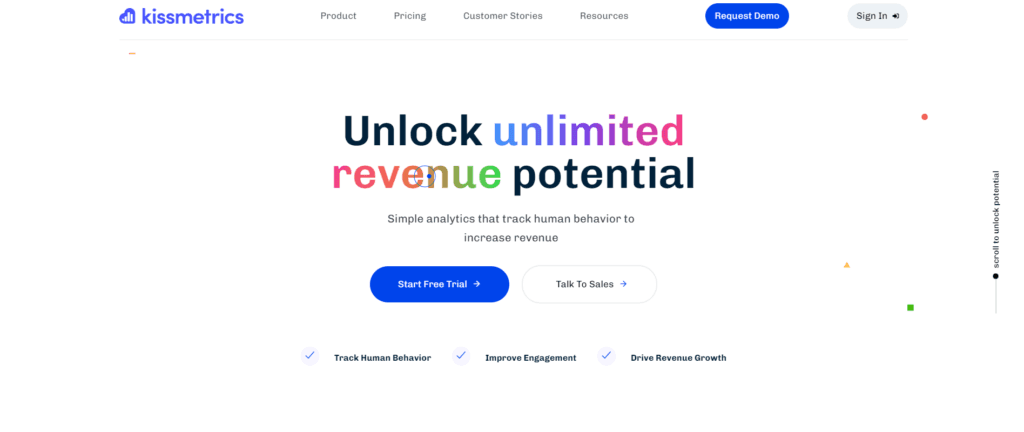
Features
- Behavior-based analytics.
- Automated email campaigns based on user behavior.
- A/B testing functionalities.
Pricing
- Plans start from $299/month.
Pros
- Behavior-triggered communication tools.
- Clear and concise reports.
Cons
- Relatively higher pricing.
- Limited customization options.
#5. Amplitude

Features
- Product analytics for web and mobile.
- User paths and retention tracking.
- Collaborative workspaces for teams.
Pricing
- Free for basic features.
- Custom pricing for advanced functionalities.
Pros
- User-friendly interface.
- Detailed product analytics.
Cons
- Limited third-party integrations.
- Advanced features require higher pricing.
#6. Woopra
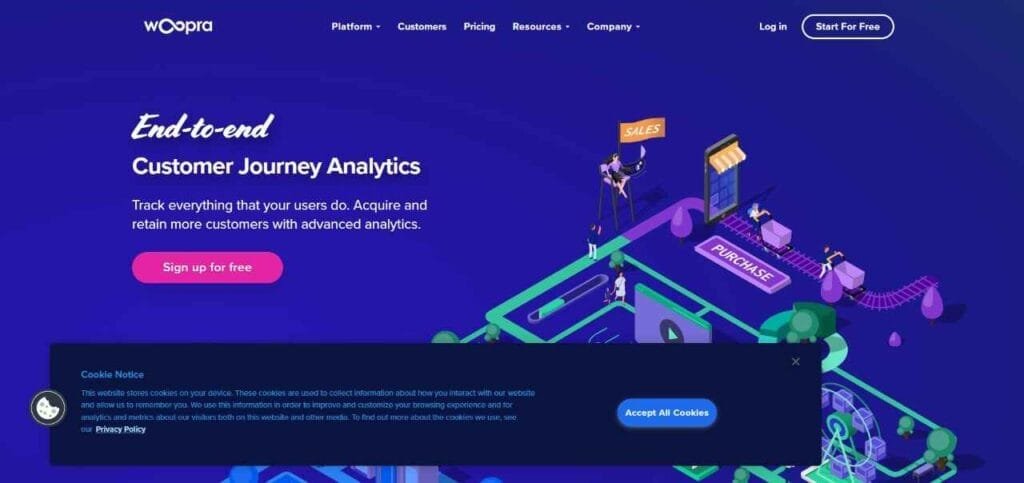
Features
- End-to-end customer journey analytics.
- Customizable tracking without coding.
- Automation features for real-time actions.
Pricing
- Free for basic usage.
- Pro plan starts at $999/month.
Pros
- Real-time data tracking.
- Seamless third-party integrations.
Cons
- Expensive for advanced features.
- Limited historical data on free plan.
#7. Retention Science (ReSci)
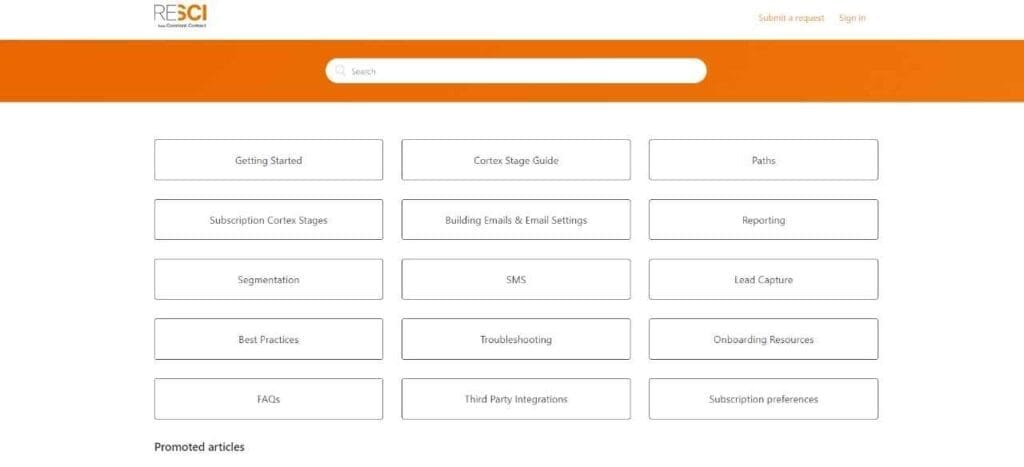
Features
- AI-driven customer retention platform.
- Personalized email campaigns.
- Predictive analytics for churn and re-engagement.
Pricing
- Custom pricing based on users and features.
Pros
- Strong AI capabilities for predictions.
- Multi-channel campaign tools.
Cons
- No transparent pricing model.
- Can be overwhelming for beginners.
#8. Heap
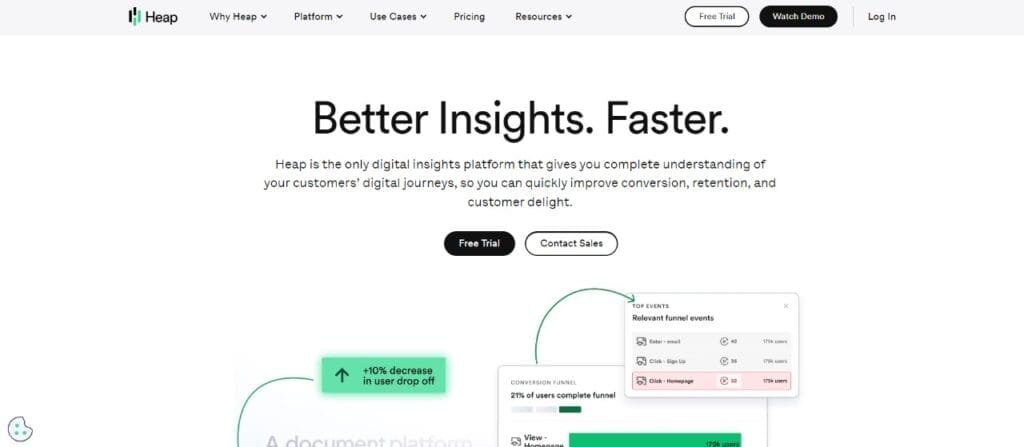
Features
- Web, mobile, and cloud product analytics.
- Automatic data capturing without extra coding.
- Funnel and retention tools.
Pricing
- Custom pricing.
Pros
- Easy setup and data capture.
- Strong retention and funnel analytics.
Cons
- Limited data on the free plan.
- Custom pricing can be expensive for some businesses.
#9. Localytics
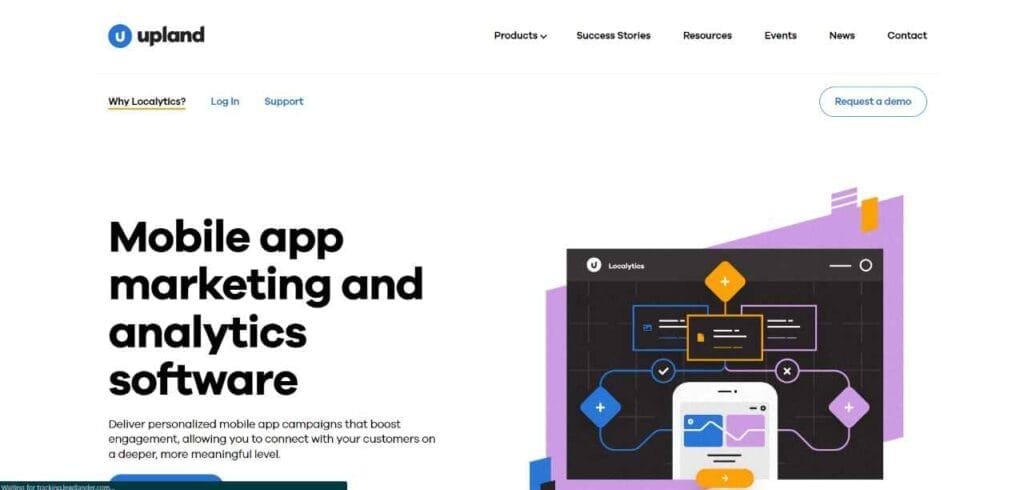
Features
- Mobile app analytics.
- Personalized mobile app campaigns.
- User segmentation and retargeting.
Pricing
- Custom pricing based on features and users.
Pros
- Strong focus on mobile analytics.
- Detailed segmentation tools.
Cons
- Pricing is not transparent.
- Mainly focused on mobile, limiting web analytics.
#10. Pendo
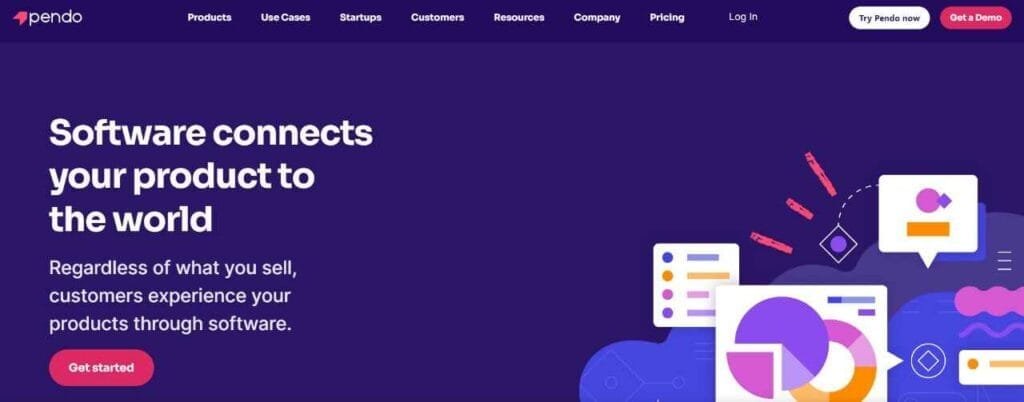
Features
- Product experience platform.
- Detailed user insights and feedback.
- In-app messaging and guides.
Pricing
- Custom pricing.
Pros
- Strong product analytics.
- User feedback collection tools.
Cons
- Can be expensive.
- Requires integration setup.
# 11. Segment
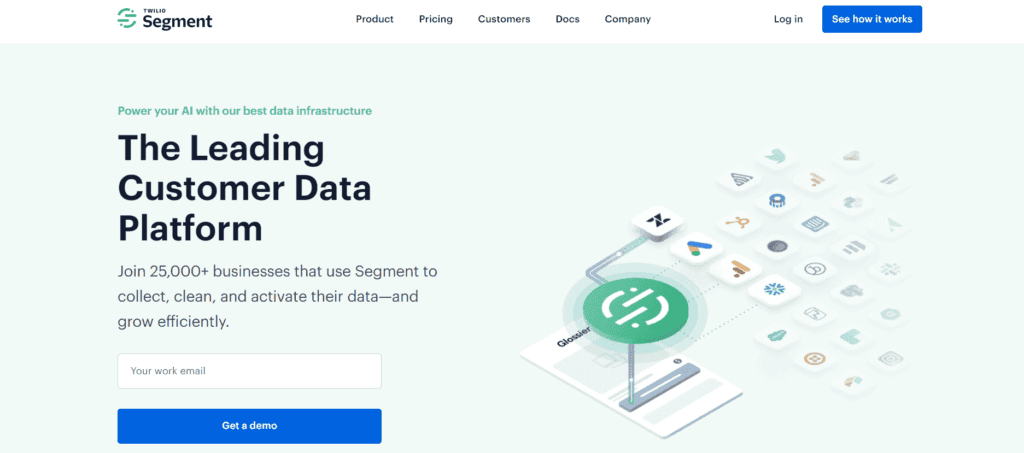
Features
- Data integration platform for unifying customer data.
- Collects data from various sources and sends it to analytics tools.
- GDPR compliant and provides data governance.
Pricing
- Free for basic functionality.
- Team and Business plans with custom pricing based on usage.
Pros
- Easily integrate data across many platforms.
- Strong partner ecosystem.
Cons
- Requires technical setup.
- Cost can add up with more integrations.
# 12. ChartMogul
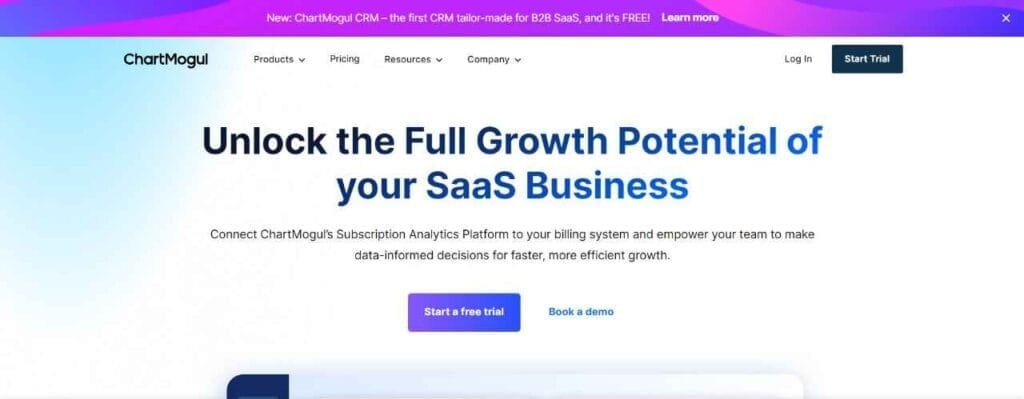
Features
- Subscription analytics for SaaS businesses.
- MRR, churn, and cohort analysis.
- Integrates with major payment gateways.
Pricing
- Plans start at $100/month.
- Custom plans available for enterprises.
Pros
- Tailored for SaaS businesses.
- Detailed revenue analytics.
Cons
- Less versatile for non-subscription-based businesses.
- Can be expensive for small startups.
#13. Optimizely
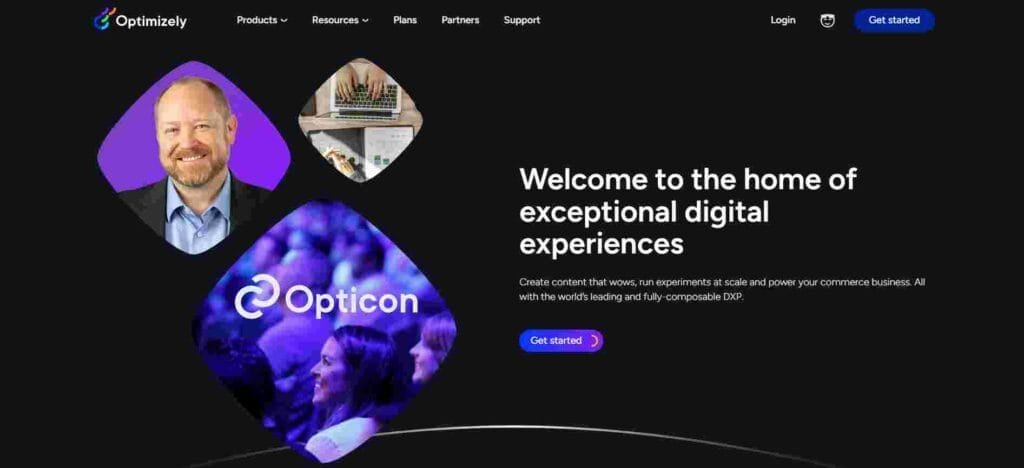
Features
- A/B testing and multi-variant testing.
- Web experimentation and personalization.
- Server-side experiments.
Pricing
- Custom pricing based on specific needs.
Pros
- Robust experimentation tools.
- Strong community and resources.
Cons
- Pricing is not transparent.
- Can be complex for non-technical users.
#14. Looker
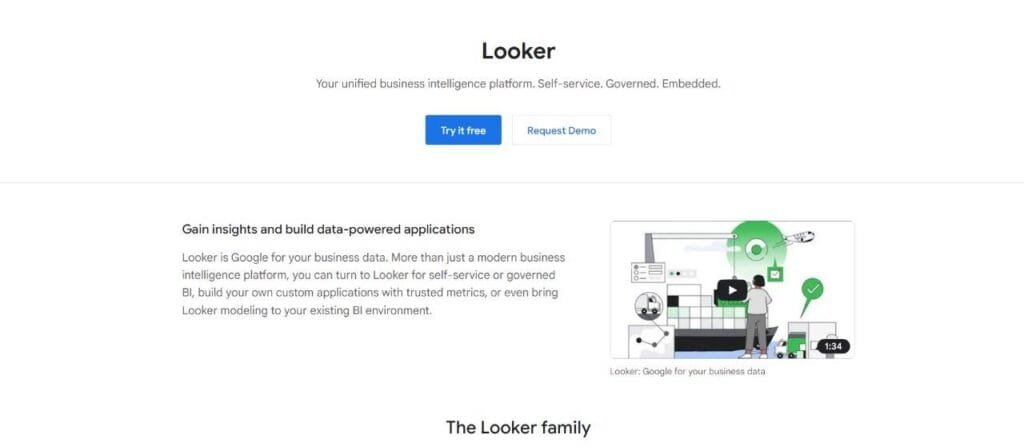
Features
- Modern data platform with BI and analytics.
- Data exploration and visualization.
- Custom applications with embedded analytics.
Pricing
- Custom pricing based on deployment size and features.
Pros
- Seamless data integrations.
- User-friendly dashboards.
Cons
- Requires SQL knowledge for advanced queries.
- Setup can be intensive.
#15. CleverTap

Features
- Mobile analytics and engagement.
- AI-driven insights and automations.
- Omnichannel marketing campaigns.
Pricing
- Free for up to 10,000 monthly events.
- Custom pricing for advanced plans.
Pros
- Focused on user engagement.
- Real-time segmentation.
Cons
- Can be expensive as events increase.
- Mainly focused on mobile analytics.
#16. Intercom

Features
- Customer messaging platform.
- In-app and email communication.
- User segmentation and targeted messaging.
Pricing
- Starting at $59/month for basic features.
- Custom pricing for advanced functionalities.
Pros
- Strong integration ecosystem.
- Personalized customer interactions.
Cons
- Can be expensive for advanced features.
- Interface can be overwhelming initially.
#17. Mode Analytics

Features
- Collaborative data platform.
- SQL, Python, and R integrated.
- Custom visualizations and reports.
Pricing
- Free for small teams.
- Custom pricing for enterprises.
Pros
- Supports multiple data analysis languages.
- Collaborative features for teams.
Cons
- Requires technical proficiency.
- Limited templates in the free version.
#18. Singular
Features
- Marketing intelligence platform.
- ROI analytics and fraud prevention.
- Unified marketing dashboard.
Pricing
- Custom pricing based on usage and features.
Pros
- Comprehensive marketing data analytics.
- Strong focus on ROI.
Cons
- Custom pricing may be unclear.
- More suited for larger enterprises.
#19. Appsflyer
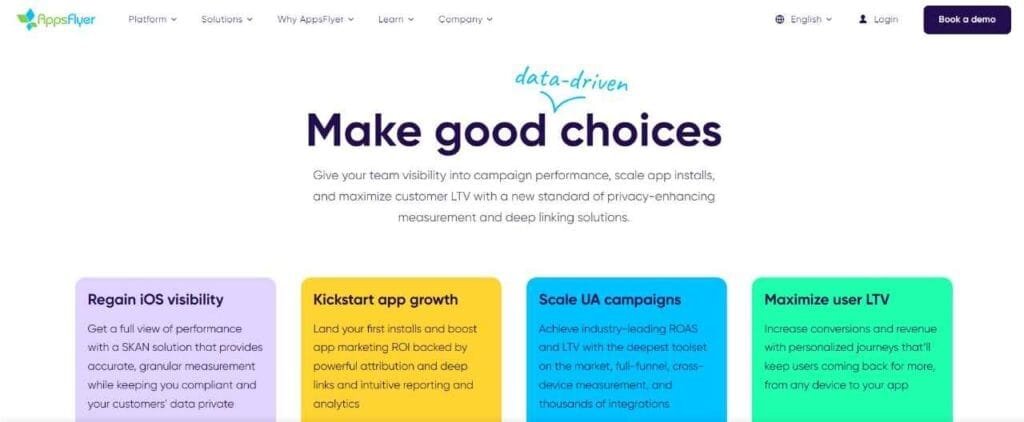
Features
- Mobile attribution and marketing analytics.
- Fraud protection.
- Omnichannel measurement.
Pricing
- Custom pricing based on monthly active users and features.
Pros
- In-depth mobile marketing insights.
- Strong security features.
Cons
- Costly for businesses with a large user base.
- Requires integration setup.
#20. Adjust
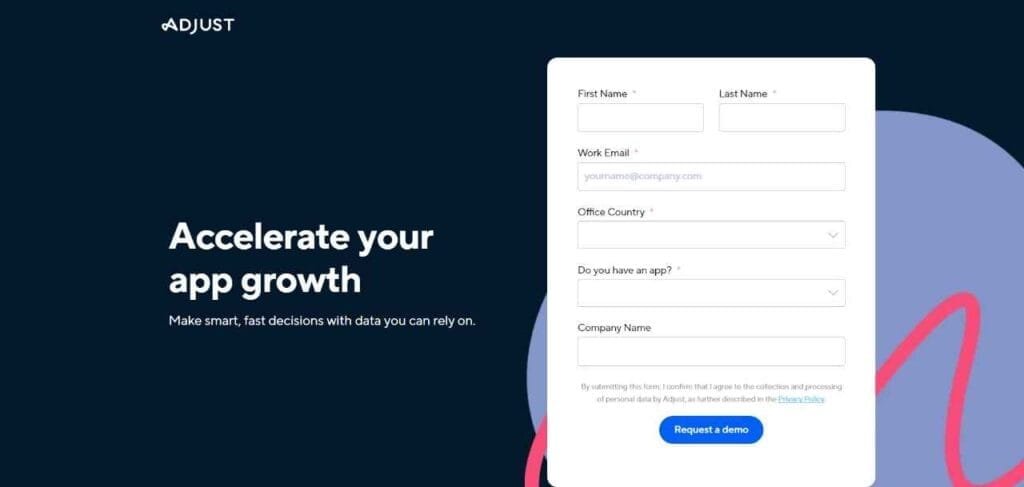
Features
- Mobile measurement and fraud prevention.
- App benchmarks and analytics.
- Automation and audience builder.
Pricing
- Custom pricing based on specific needs.
Pros
- Comprehensive mobile analytics.
- Strong fraud prevention tools.
Cons
- Pricing can be on the higher side.
- Mainly tailored for mobile-centric businesses.
Overcoming Challenges in Retention Advertising
Any advertising strategy, even one geared towards retention, will face hurdles. From ad fatigue to ever-evolving customer preferences, understanding these challenges and proactively addressing them is paramount.
Addressing Issues Like Ad Fatigue and Overexposure
Ad fatigue occurs when your target audience sees your ads so often that they become less effective. Overexposure can lead to diminished returns and can even have a negative impact on brand perception.
Rotate Ad Creatives: Regularly switch up the visuals and messaging of your ads to keep them fresh and engaging.
Segment and Target: Avoid blasting the same ad to your entire customer base. Segment your audience and tailor ads to each group to ensure relevance.
Implement Frequency Caps: Most ad platforms allow for frequency caps which limit how often a particular user sees an ad.
Strategies for Continuously Refreshing Ad Content
Stay Updated with Market Trends: Market dynamics change. By staying updated, you can align your ads with what’s current and relatable.
Involve the Community: User-generated content or ideas from loyal customers can be a goldmine for fresh ad content.
Seasonal and Thematic Ads: Festive seasons, holidays, or even global events can be excellent opportunities to revamp your ad creatives.
Handling and Converting Dissatisfied Customers Through Targeted Campaigns
A dissatisfied customer can be converted into a loyal one if their concerns are addressed effectively.
Active Listening: Use platforms like social media to listen to grievances. Responding promptly can mitigate negative sentiments.
Personalized Apology Offers: If a customer had a poor experience, a personalized ad offering a discount or a special offer can win them back.
Feedback Loop: Implement systems to collect feedback post-purchase. Understanding areas of dissatisfaction allows for proactive improvement.
Future Trends: The Evolution of Retention Advertising
The realm of retention advertising, like all digital landscapes, is continuously evolving. Let’s delve into where the future might be leading us.
Predictive Analytics and AI in Personalized Retention Campaigns
The power of artificial intelligence combined with data analytics can forecast customer behavior, making retention strategies more proactive than reactive.
Tailored Experiences: AI can analyze past behavior to predict what a customer might be interested in next, leading to hyper-personalized ads.
Chatbots and Virtual Assistants: They can offer real-time assistance, making customers feel valued and attended to.
The Growing Role of Interactive Content and AR in Customer Loyalty
Interactive Ads: Quizzes, polls, and interactive videos can boost engagement, making users feel involved with the brand.
Augmented Reality (AR): Brands like IKEA and Sephora are already using AR to let customers visualize products before buying. Such immersive experiences can significantly boost loyalty.
The Potential of Community-Building as a Retention Strategy
Brands are realizing that loyal customers don’t just buy products; they buy into communities.
Engage Beyond Transactions: Hosting webinars, workshops, or even casual meet-ups can foster a sense of community.
Leverage User-Generated Content: Showcase stories from your community. When customers see real people enjoying your products, the trust factor multiplies.
Wrapping it up
The strategic pivot towards retention advertising reflects the evolution of today’s competitive marketplace. Prioritizing existing customers, brands can foster deeper relationships, ensuring not just transactional loyalty but emotional bonds.
This guide underscores the myriad tools and strategies at a brand’s disposal, from personalization to leveraging emerging technologies. As challenges arise, they present new avenues for innovation and adaptation.
Ultimately, for modern businesses, retention advertising isn’t merely an option; it’s a cornerstone for sustained growth and brand legacy.
Read Next:



